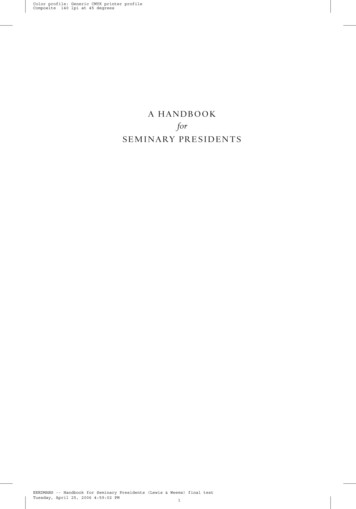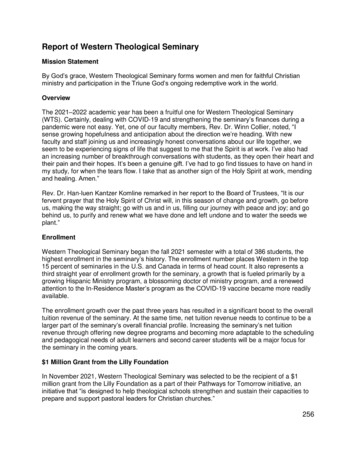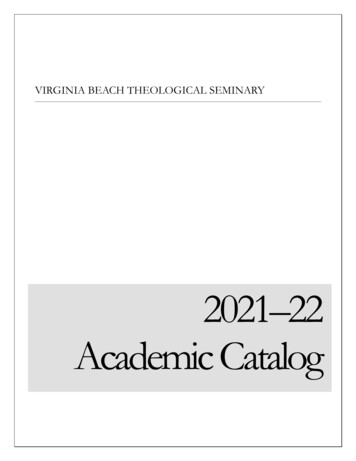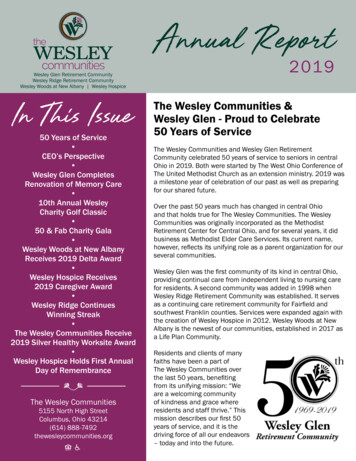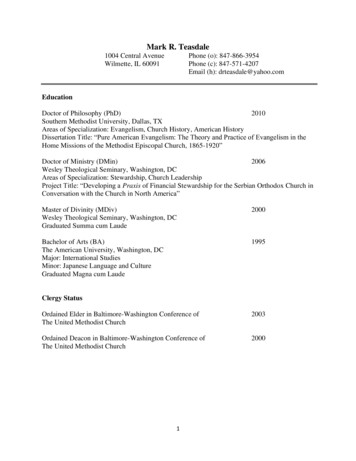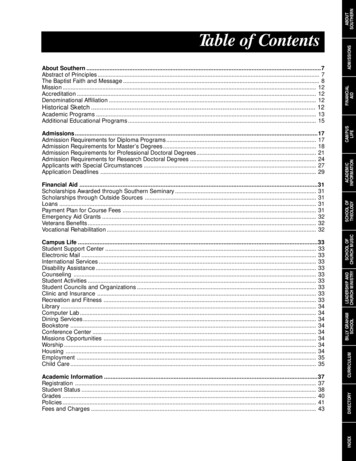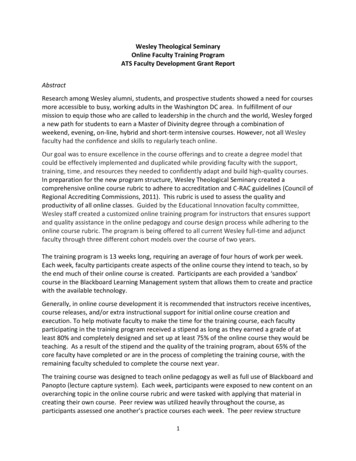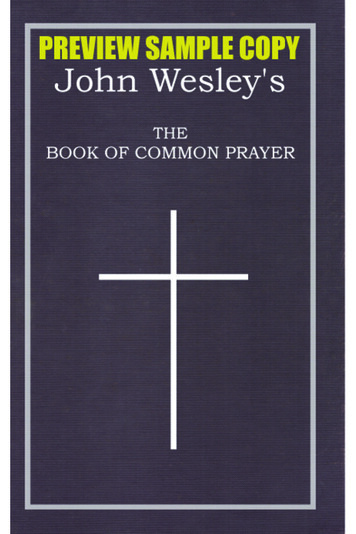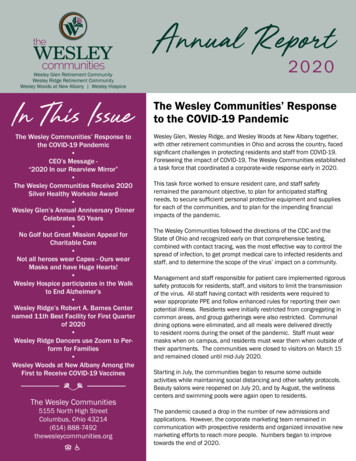
Transcription
THE WESLEY THEOLOGICAL SEMINARYANSWER THE CALLA CAMPUS PLAN TO THRIVE IN PLACEYEAR 2022 THROUGH 2032MARCH 17, 2022ZONING COMMISSIONDistrict of ColumbiaCASE NO.22-13EXHIBIT NO.3
TABLE OF CONTENTSPage Nos.EXECUTIVE SUMMARY1I.THE SEMINARY AND THE DISTRICT OF COLUMBIA9A.B.C.D.E.9101213151517181920F.Overview, Mission and HistoryAccreditation and Institutional AffiliationsProgramsResearchThe Wesley Seminary Community1. Enrollment2. Faculty3. Governance and Management4. The Financial PictureWesley's Ministry in the Neighborhood, Washington and the WorldII.SHAPING THE WESLEY SEMINARY CAMPUS OF THEFUTURE23III.SPRING VALLEY CAMPUS 202125IV.CAMPUS PLAN TO THRIVE IN PLACE (2022-2032)26A. Demolish Old President’s House and Restore Site with LandscapingB. Demolish Carroll and Straughn Halls and Surface Parking LotC. New Student Housing for Wesley and American University1. Landmark Properties2. No Agreement with American UniversityD. New Residential Style/Scale Admin/Faculty/Maintenance BuildingE. No Development of University Avenue Residential LotsF. Maintain “Hilltop” CampusG. Maintain and Enhance Green Open Space Buffer Zone on UniversityAvenue and Massachusetts AvenueH. 270,000 Square Feet of Unused Gross Floor AreaI. Community Playground2627272830313232V.COMMUNITY OUTREACH AND PARTICIPATION34VI.THE WESLEY CAMPUS: EXISTING AND PROPOSED36A.B.C.D.36373740Location, Boundaries and ZoningProperty OwnershipLand UseBuilt Environmenti4895-8748-3651.v7323334
E.F.G.H.I.VII.Open Space and Pedestrian NetworkHistoric PreservationCampus IdentityTransportationUtilitiesZONING REGULATION COMPLIANCEA. College or University which is an Academic Institution of HigherLearningB. The Use is Located So That It Is Not Likely to Become Objectionable toNeighboring Property1. Noise2. Traffic3. Number of Studentsa. Enrollment and Residentsb. PersonnelC. Compliance with The Maximum Bulk RequirementsD. Submission of a Plan for Developing the Campus as a Whole1. Building, Parking and Loading Facilitiesa. Buildingsb. Parkingc. Loading2. Screening, Signs, Streets, Public Utility Facilitiesa. Screeningb. Signsc. Streetsd. Public Utilities3. Athletic and Other Recreational Facilities4. Description of All Activities and Capacity of All Present andProposed Campus DevelopmentE. Interim Use of Land is ContinuedF. No New Use Sought for Approved Site of Buildings Moved OffCampusG. Compliance with the Policies of the District Elements of theComprehensive PlanH. The Proposed Buildings are Within the Floor Area Limit for theCampus as a WholeI. Referral to the District of Columbia 53535454545555555656VIII.PROPOSED CONDITIONS57IX.CONCLUSION61ii4895-8748-3651.v7
TABLE OF EXHIBITSExhibit A:Exhibit B:Exhibit C:Exhibit D:Exhibit E:Exhibit F:Exhibit G:Exhibit H:Exhibit I:Exhibit J:Exhibit K:Exhibit L:Exhibit M:Exhibit N:Exhibit O:Exhibit P:Exhibit Q:Exhibit R:Exhibit S:Exhibit T:Exhibit U:Exhibit V:Exhibit W:Exhibit X:Site LocationStudent Enrollment TrendsBoard of GovernorsZoning Commission Order No. 05-40CSite Zoning PlanBuilding ElevationsStreet View RenderingsLandscaping PlanIntentionally DeletedExisting and Proposed Property BoundaryExisting ZoningExisting Land UseExisting Building Use and InfrastructureExisting Building HeightsExisting Open Space and Pedestrian SystemProposed Open Space and Pedestrian SystemExisting Site AmenitiesExisting Vehicular Circulation NetworkProposed Vehicular Circulation NetworkMajor UtilitiesProposed Land UseProposed Building Use and InfrastructureProposed Building HeightsProposed Site AmenitiesThe figure of Christ on the exterior wall of the chapel facingMassachusetts Avenue was carved on site.iii4895-8748-3651.v7
EXECUTIVE SUMMARYSUMMARY OF THIS APPLICATIONIn 2006, the Wesley Theological Seminary of the United Methodist Church (“WesleySeminary”) obtained approval for its first Campus Plan (2006-2015). Since then, changingcircumstances required Wesley Seminary to reevaluate and restructure its original Campus Planon several occasions. Through this process, Wesley Seminary has successfully evolved in itseducational mission and facilities to serve that mission. This new Campus Plan for 2022 through2032 and beyond, provides facilities and resources for Wesley Seminary to Thrive in Place asone of the top twenty theological seminaries and continue its leadership locally, regionally,nationally and internationally.CAMPUS PLAN (2006-2015)In 2006, the Zoning Commission in Z.C. Case No. 05-40 approved Wesley Seminary’sfirst Campus Plan which supported its academic and religious mission with a 21st centurycampus achieved by a combination of renovation, demolition, and new construction whilemaintaining the scale and feel of the existing hilltop campus. This Plan maintained the currentlevel of enrollment and added 72,500 square feet of gross floor area. Approximately 30,000square feet of Residential Space; approximately another 30,000 square feet of Academic Space;approximately 5,000 square feet of Chapel Space; and 7,500 square feet of Support Space wereto be added to the Campus.14895-8748-3651.v7
CHANGING CIRCUMSTANCES RESULT IN RE-EVALUATION OFCAMPUS PLANThe original Campus Plan was an ambitious and aspirational vision for the Seminary. Aprolonged economic downturn, declining enrollment, and changes in theological educationforced a re-evaluation of that Campus Plan. While the Campus Plan was being restructured,Wesley Seminary continued to invest in its facilities and programs, including an upgrade of itsunderground utilities, removal and/or remediation of all asbestos, establishing the “Wesley atMount Vernon Square” offsite facility, and renovations of the existing Library and Chapel.AMENDED CAMPUS PLAN (2012-2025)Approved in Z.C. Case 05-40A, this Plan was developed to meet the Seminary’s strategicvision with more limited resources and evolving needs. The approved amendment and extensionof the original Campus Plan until 2025 maintained the levels of student, faculty, and staff, butsubstantially reduced the previously approved new construction. The existing Campus facilitieswere maintained without demolition and several previously approved new buildings wereeliminated. The only addition to the Campus was the new 3-story, 76 bed Residence Hall thatwas opened in 2014. Additionally, the two existing 1960-era residential buildings, Chapel andLibrary were renovated, all buildings were made handicapped accessible, major renovation and“greening” of utilities was accomplished and IT was brought to current standards. Surfaceparking was increased, and other campus enhancements made.MODIFICATION OF CAMPUS PLAN (2016-2019)In 2016, in the aftermath of the economic recovery from 2008, nationwide seminaryenrollment continued to be weak and in decline. Despite its top-tier reputation and uniquelocation, Wesley Seminary was not immune from this trend. In Zoning Commission Order No.24895-8748-3651.v7
05-40B, the Zoning Commission authorized Wesley Seminary to allow up to fifty-five (55) nonWesley graduate students to occupy Straughn Hall through May 2019.MODIFICATION OF CAMPUS PLAN (2017-2019)In Zoning Commission Case No. 05-40C, the Zoning Commission approved theexpansion of housing on campus for non-Wesley graduate students. Through December 2019,fifty-five (55) non-Wesley graduate students were permitted in Straughn Hall, six (6) in CarrollHall and twenty-six (26) in the New Residence Hall. (Exhibit D).MODIFICATION OF CAMPUS PLAN (2019-2020)Wesley requested, and the Zoning Commission in Case Number 05-40D approved a oneyear extension of its current Campus Plan under the existing conditions until December 31, 2020.AUTOMATIC AND ADMINISTRATIVE TIME EXTENSIONS.As a result of the COVID-19 pandemic and D.C. public health emergency, the ZoningCommission automatically extended the current Campus Plan six-months until June 30, 2021.Wesley Seminary requested and received an additional six-month extension until December 31,2021 by Zoning Commission Order No. 05-40-D(1). In order to continue its communityengagement process, Wesley Seminary requested and received an additional six-month extensionuntil June 30, 2022 in Zoning Commission Order No. 05-40D(2).THRIVE IN PLACE CAMPUS PLAN (2022–2032)The 2022 Plan is a renewed commitment by Wesley Seminary, a leading national andinternational theological educational institution, to its Spring Valley Campus and its role in34895-8748-3651.v7
Washington, D.C., regionally, nationally and internationally. This Plan will allow WesleySeminary to “Thrive in Place” for the long-term.The 2022 Plan proposes to demolish two 1960 - era dormitories (Straughn Hall andCarrol Hall) with ninety beds and demolish the Old President’s House (including parking area,driveway and curb cut) on University Avenue and re-landscape that area, including a smallneighborhood playground. The existing surface parking lot (105 spaces) and adjacent one-storymaintenance building will be demolished and replaced with a new dormitory with approximately659 beds and 300-350 underground parking spaces to be constructed by Landmark Properties, aleading nationwide student housing provider, under a long-term ground lease with WesleySeminary. This new dormitory will be offered exclusively to Wesley Seminary students (andtheir immediate families) and to American University students needing local housing. A newtwo-story residential scale and design administrative building with lower-level maintenancefacility will be constructed at the top of the University Avenue driveway adjacent to the NewResidence Hall constructed in 2014. The other existing Wesley Seminary buildings, includingKresge Academic Hall, Trott Administration Building and Chapel, Library and New ResidenceHall will remain in place as the perimeter of the existing hilltop campus.The 2022 Plan will maintain and enhance the existing Green Open Space Area Bufferwith the adjoining neighborhoods on University and Massachusetts Avenues. Fully 55%(210,000 square feet) of the Campus area will remain Green Open Space. The total gross floorarea proposed will result in a total floor area ratio (“FAR”) of approximately 1.1, well below themaximum 1.8 FAR permitted. No further development of the property is contemplated;approximately 270,000 square feet of gross floor area will not be developed.44895-8748-3651.v7
INTRODUCTION TO WESLEY SEMINARYWesley Seminary, founded in 1882, is one of the nation’s leading and largest graduatetheological schools (most of which are known as “seminaries” or “divinity schools”). Wesleymoved to this campus 63 years ago from what is now McDaniel University in Westminster,Maryland. Most of the current buildings were constructed at that time, except for a residencehall built in 2014. All other buildings are renovated.Wesley Seminary came to this site and designed our campus to share this academichilltop with American University, a sister school in the United Methodist denomination. Thiswas part of a larger plan of a Methodist Bishop who chaired the boards of both schools and whoalso established the A.U. School of International Service and relocated Sibley Hospital with avision for a “Methodist Center” in this region, joining with the National United MethodistChurch in Wesley Heights.Wesley is considered one of the few truly national and international seminaries. Centerprogressive and one of the most ethnically diverse, our alumni serve as pastors and leaders ofnon-profit human service organizations around the world, including a strong presence here inWashington. We are broadly ecumenical, with students from 26 denominations and a similarnumber of both states and foreign countries. We offer three Master’s degrees and a Doctor ofMinistry (D.Min.) and several non-degree programs, with three substantial centers of researchand teaching: Leadership, Arts and Religion, and Community Engagement. Our currentenrollment is 372 Masters students and 347 D.Min. students. Pre-Covid, two-thirds of Master’sstudents commuted. D.Min. students come for two-week intensive sessions.54895-8748-3651.v7
The stained glass windows in the chancel of the chapel depict Christ's ministry and itsextension on the world.Since 1958, the Spring Valley campus has been an academic oasis in the midst of andbenefiting from the unique cultural diversity and excitement of the Nation's Capital. WesleySeminary offers a variety of programs and experiences, including masters and doctoral degreeprograms and important non-degree programs which respond to the diverse needs of our studentbody and their individual ministries. Wesley Seminary has also become a center for theologicalresearch as a resource not only for the campus, but on a much broader basis regionally,nationally, and internationally.64895-8748-3651.v7
The Wesley Seminary Campus is deceiving. Although outwardly tranquil and relaxed, itis, in reality, a place of great energy and excitement. Wesley Seminary has not only embracedbut taken the lead in the 21st century of theological education. In order to continue this journeyfrom its Spring Valley Campus, Wesley Seminary must use its physical and financial resourcesto support and foster its educational mission. Most importantly, the Seminary must be able toattract the best and brightest faculty and students to maintain and elevate its place among the toptwenty theological schools.The reason for this development is not for Wesley to survive, rather, to allow us to thrivein place for the next generations. By some reckoning, the most prudent move for Wesley wouldbe to sell this campus and relocate to a less expensive area in the mid-Atlantic region. But weare resolved to remain in Washington because we believe this city is central to our mission andour ability to attract both students and faculty. Wesley greatly values being a part of anacademic community committed to liberal higher education with all the vibrancy that entails.Wesley and A.U. have always had some shared programing, but, under A.U. President SylviaBurwell, those connections are expanding.We must also be able to thrive in place financially. The size of the new student housingbuilding provides for the number of beds necessary to house Wesley students (and theirimmediate families) and to achieve the financial benefit which is critical to our ability to remainin this neighborhood and be one of the leading seminaries in perpetuity. Wesley is currently oneof only 30 seminaries competing nationally and internationally for the best students and faculty.But we are 20th in size of endowment. In a period of winnowing of the number of seminariesnationwide, this project would effectively move us to 10th. The high-end design of this dorm74895-8748-3651.v7
provides our students access to amenities they do not have now and enhances Wesley’s appeal toyounger students.We will devote most of the financial benefit to further subsidize student scholarships.The fundamental economics of our business are extremely difficult as we strive to ordainministers who have a graduate-level education similar in length and depth to medical students,but they will earn a fraction of the salary over a lifetime. And so, our ability to discount the costof this education is determinative of our ability to compete.Beyond that, Wesley is a national leader in research and innovation. Our growth edge isin non-degree and certificate education and other programs to support the church nationally andinternationally. This growth does not have an impact on our home campus. But we must be ableto thrive in place to have a home base of faculty and students in the more traditional mode ofeducation with all Washington has to offer.84895-8748-3651.v7
A statue of Moses striking the rock adorns the courtyard outside the library.I.THE SEMINARY AND THE DISTRICT OF COLUMBIAA.Overview, Mission and HistorySituated on nine acres in Northwest Washington, D.C., positioned between AmericanUniversity and the Spring Valley neighborhood (Site Location, Exhibit A), the WesleyTheological Seminary of the United Methodist Church (“Wesley Seminary”) is a graduatetheological school. The mission of Wesley Theological Seminary is to equip Christians forleadership in the church and the world, to advance theological scholarship, and to provide aprophetic voice in the public square. To pursue that mission, the primary focus is the preparationof exceptional leaders for churches, and human service non-profit leaders. Its rolling Campusoffers an academic oasis enhanced by the excitement and cultural diversity of the city.94895-8748-3651.v7
Wesley Seminary was founded in 1882 as a small seminary at Western MarylandCollege. Wesley Seminary moved from its Westminster, Maryland location to its currentCampus in 1958. The institution flowered in size and stature on the new Campus and its locationbecame the foundation of its identity and success. The original buildings that will remain haveall been renovated and the new Residence Hall added in 2014. Over its first sixty-three years,Wesley Seminary grew to fill out its Campus reflecting all the changing patterns of seminaryenrollment and trends in theological education.The statue of John Wesley - here in special attire - was a gift to the seminary onbehalf of British Methodists.B.Accreditation and Institutional AffiliationsWesley Seminary is fully accredited by The Association of Theological Schools in theUnited States and Canada, the Commission on Higher Education of The Middle StatesAssociation of Colleges and Schools, The University Senate of The United Methodist Church104895-8748-3651.v7
(Board of Higher Education and Ministry), and the District of Columbia Educational LicensureCommission.Wesley Seminary is one of the thirteen official seminaries of The United MethodistChurch, a ubiquitous denomination with a church in nearly every zip code of the United Statesand nearly every nation. Degree programs are structured to insure all denominational ordinationand consecration requirements will be met, and ordination information and counseling is offered.At the same time, Wesley Seminary is broadly ecumenical ranging from Unitarian toPentecostal. Students from over 26 other denominational backgrounds make up 48% of thecurrent student body. Wesley Seminary enjoys a special relationship with the Episcopal Dioceseof Washington. Students from a variety of Baptist traditions make up one of the largerdenominational groups at Wesley Seminary.Wesley Seminary is a founding member of the Washington Theological Consortium.The Consortium offers Wesley Seminary students a rich array of opportunities through closerelationships with other major theological schools in the Washington area. Within minimalguidelines, students have access to the curricular offerings of all these schools and may crossregister for degree credit while paying tuition to their home school.Wesley Seminary shares a Methodist heritage with its neighbor, American University(A.U.). They are separate institutions, but share several academic programs and, until recently,also shared utilities.114895-8748-3651.v7
C.ProgramsWesley Seminary provides in-depth study and reflection on the texts and traditions of ourfaith through the scholarly work of our faculty and the research capability of our library, throughour Masters and Doctoral-level degree programs, and through our non-degree programs designedto reach both clergy and laity. The primary focus of the Wesley Seminary is to prepare leadersfor the church. Wesley Seminary students are formed for a kind of leadership which draws fromthe texts and traditions of the faith so they may lead the church in mission and ministry in theworld.The hub of our academic programs is the Master of Divinity (M.Div.), an 81-creditdegree which is the normal academic requirement for candidates for ordained pastoral ministryfor the Protestants, Roman Catholics, and Eastern Orthodox. This is a longer Masters degreebecause it is a professional degree, which means that a third of the program covers variousaspects of the practice of ministry. Also, a candidate for the M.Div. need not have studiedreligion or theology in undergraduate school. This means that the seminary curriculum includesboth lower-division, lecture hall style, introductory courses in Bible, Theology, Church History,and Ethics and upper-division, seminar style, reading courses. These layers in M.Div. educationcreate special requirements for the design of classroom space.Wesley Seminary offers two other Master’s degrees and a doctoral program. The Masterof Theological Studies (M.T.S.) 60 credit and the Master of Arts (M.A.) 36 -credit degrees. TheM.T.S. is taken by students who may be pursuing professional ministry positions not requiringordination, as a prelude to Ph.D. work, or simply for personal enrichment. The M.A. is forpersons working in specialized ministry fields outside of pastoral ministry. The Doctor of124895-8748-3651.v7
Ministry (D.Min.) 30 credit degree is an in-service, advanced degree for pastors and other churchleaders seeking a deeper learning and new skills for ministry.Night classes, hybrid schedules and online learning and partnering opportunities aredesigned to accommodate both full-time and part-time students. The Master’s degrees are takenon a semester system with the fall semester running late August through mid-December and aspring semester running mid-January through early May and a May-July set of summer schoolcourses. The Doctor of Ministry degree is taken in two-week intensive sessions in early Januaryand May when the full-time students are not on campus.Wesley Seminary also offers significant non-degree programs which are expanding. Thelargest is the Course of Study School, held late-June through July, is for those who are serving asbi-vocational part-time pastors of rural churches.D.ResearchThe Wesley Seminary library participates in the American Theological LibraryAssociation and the Washington Theological Consortium, which allows us to focus ourcollection of about 135,000 volumes on theological works and a few other special holdings.Over time, Wesley Seminary has established three centers of specialized work andresearch to serve both our students and the broader church and society. To be “centered in theseminary” means that it is a resource to all existing degree programs of the seminary. To be “aCenter for” means that the Center would help Wesley Seminary fulfill its vision to be a churchbased seminary by providing resources beyond the degree programs.134895-8748-3651.v7
The Henry Luce III Center for Arts and Religion was a first among seminaries toseriously introduce the language and sensibilities of the arts in a theological school. The Center'son-campus facilities include a fine arts studio with an open-door policy for the Seminarycommunity and the Dadian Gallery, which is open to the public throughout the year. The Centersponsors residencies for artists in a wide array of mediums, dialogues between artists andtheologians, and regularly scheduled exhibits in the Dadian Gallery.The G. Douglass Lewis Center for Church Leadership was formally established in July2003 to be a Center for the church, centered in the seminary. This is the largest of our centerswith a staff of seven, offering workshops, seminars, podcasts, consulting and an onlineconstituency of 20,000.The newest entity is the Community Engagement Institute, which helps students, pastorsand congregations engage effectively in the public square, including a leading program in publictheology.Wesley Seminary also specializes in research and programs in congregational vitality.We run more grant-funded research programs than any other seminary, many funded by the LillyEndowment. One current program bears directly on the future design of seminaries, aquantitative and qualitative study of the “Changing Nature of the Religious Workforce.”Many seminaries offer some of the kinds of programs listed above. Very few offer thisfull range and depth of theological education. All of these programs can be explored in moredetail on our website: www.wesleyseminary.edu.144895-8748-3651.v7
E.The Wesley Seminary CommunityPreparing an individual for ministry is a formation of the whole person, involvingintellectual, emotional and spiritual discipline, and the practical skills and insights necessary foreffective leadership. We believe that forming people for ministerial leadership requires acommunity that embraces both our diversity of culture and our unity in Jesus Christ. Part of therequirement in the Master’s program is an “immersion” experience so that students spend aperiod of time in a culture not their own.Central to our community is our worship in Oxnam Chapel. Services are at Noon onTuesday in the chapel. There are other smaller prayer and worship meetings around the campusthroughout the week. In addition, students participate in small groups for study and meditation.Space for worship and small group interaction is a critical component in our campus design.1.Enrollment(Exhibit B) shows the trends in Wesley’s enrollment over a five-year period broken downby degree program. Fiscal Year 2008 witnessed the peak in overall student enrollment afteralmost a decade of steady growth. After Fiscal Year 2008, there has been a significant decreasein the number of students, but an increase in the number of course hours taken by each student.The total number of students has fallen to the levels in 2000-2001 because of the decline of thetraditional Master of Divinity degree. Yet, the Doctor of Ministry degree has shown substantialincrease and the Master of Arts has remained strong, reflecting the changing market for seminaryeducation. Over time the student population will continue to fluctuate upwards and downwards,but the scale of the community will remain self-contained and intimate. Wesley Seminary doesnot plan to expand beyond the population caps established by its current Campus Plan.154895-8748-3651.v7
The diversity of the student body is both demographic and programmatic.Demographically, the enrollment trends at Wesley Seminary are in the same direction as the restof Mainline Protestant. For example, 62% of our Master’s candidates are women; 39% of ourstudents are African-American, giving Wesley, an historically “white” institution, one of thehighest number of black seminarians in the country. There is also a wide range of ages.Underneath these statistics is the diversity of background and life experiences these percentagesrepresent. This is both a wonderful resource and a great challenge to the task of education andformation. The trends also show an increased diversity of program.Wesley Seminary’s community also includes a number of people involved in non-degreeprograms. The largest of these is the summer Course of Study, which enrolls approximately 210students.The hidden dynamic in Wesley Seminary’s enrollment is the prevalence of the part-timestudents and the diversity of vocational directions. Wesley, like all seminaries, was designed andacculturated to the young, full-time resident student focused on a lifetime of pastoral ministry.There is a strong feeling within theological education that this monastery-like community is theideal way to form people for ministry. But Wesley Seminary made a series of decisions over theyears to accommodate people at different places in their lives with differing senses of their futureministry. As a result, we expanded the range of programs and the flexibility of schedule.All this diversity means that Wesley Seminary is a community of communities. One ofour greatest challenges is to foster a community that forms all these people for ministry. This isa guiding consideration in the creation of this Campus Master Plan: we are still small enough tobe self-contained with the elements of the cloistered life essential to ministerial formation.164895-8748-3651.v7
2.FacultyWesley Seminary’s faculty are some of the most well-known and widely published intheological education. All 31 full-time faculty have earned doctoral degrees from accreditedinstitutions of higher learning. Diverse points of view are recognized as a virtue to beappreciated, not an obstacle to be overcome. Their work has been described as “deep center,”taking the scriptures seriously, attuned to the challenges of the modern world and committed to aministry of love and reconciliation, but large enough to offer a broad educational and theologicalexperience to meet the needs of a diverse student body.Wesley Seminary faculty members are nationally recognized as leaders in each of thetheological school disciplines: Bible, theology, ethics, church history, pastoral care, preachingand worship, Christian education, sociology, and anthropology of religion. In addition to beingdistinguished scholars and teachers, the faculty are some of the most sought-after consultants,teachers, and preachers in the Church. Providing adequate space for the faculty itself to beformed as a community of scholars is an important part of this Campus Master Plan.174895-8748-3651.v7
One third of the entering class of students is in their twenties.3.Governance and ManagementWesley Seminary is governed by a 40-member Board of Governors that includesoutstanding civic and business leaders whose dedication continues to challenge and guide theSeminary to new heights. Current and former Board members include pastors of significantchurches, a retired Marine Corps four-star general, a former D.C. City Administrator, a majorreal estate developer and a university president, two bio-tech scientists, three Bishops, and otherprominent clergy and laypeople. A list of current Governors is included in (Exhibit C).Board members keep the Seminary faithful to its mission. They develop the Seminary'sbroad policy framework and they hire and oversee the administration that implements thosepolicies. The Board and its committees me
the wesley theological seminary a campus plan to thrive in place year 2022 through 2032 march 17, 2022 answer the call zoning commission district of columbia case no.22-13 exhibit no.3. i 4895-8748-3651.v7 table of contents page nos. executive summary 1 i. the seminary and the district of columbia 9


